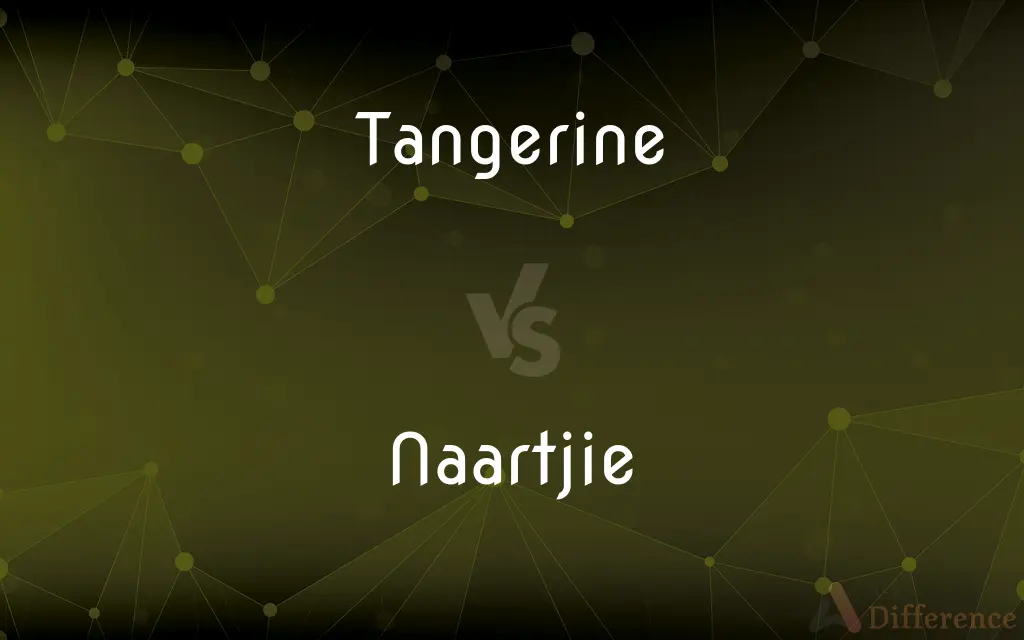Tangerine vs. Naartjie — What's the Difference?
By Tayyaba Rehman — Updated on November 3, 2023
Tangerines are a variety of mandarin oranges, small and sweet; naartjies are a South African term for a type of soft, easy-to-peel tangerine.

Difference Between Tangerine and Naartjie
Table of Contents
ADVERTISEMENT
Key Differences
Tangerines are a specific type of mandarin orange, recognized for their deep orange color and sweet flavor. They are a popular fruit worldwide and are named after Tangier, Morocco, from where they were first shipped to Europe. Tangerines have a loose skin which makes them easy to peel, and they are typically available in winter.
Naartjie is a term used predominantly in South Africa to describe a soft, loose-skinned mandarin. Naartjies have a sweeter taste and are known for their distinctive, almost spongy peel. This term is less common outside of Southern Africa and is often used interchangeably with tangerine in that region.
When it comes to usage, "tangerine" is the term more widely used internationally to describe this fruit of the Citrus reticulata family. They are often used in various culinary dishes, from salads to desserts, and are valued for their zesty citrus flavor. Tangerines are a winter fruit, commonly associated with Christmas in many Western cultures.
On the other hand, "naartjie" might not be recognized outside of Southern Africa. This citrus fruit is enjoyed not only for its taste but also for its easy-to-peel nature, making it a popular snack among children. Naartjies are similarly used in culinary preparations, but they hold a particular place in South African culture as a traditional snack.
Culturally, tangerines are widespread and recognized in global markets, celebrated in festivals, and have a place in international cuisine. Naartjies, while similar in nature, are deeply rooted in South African culture and may not be as readily available or recognized in other parts of the world. Both fruits share many similarities, but their nomenclature and cultural significance set them apart.
ADVERTISEMENT
Comparison Chart
Origin of the term
Named after Tangier, Morocco
Afrikaans origin, specific to South Africa
International Recognition
Widely recognized and used term
Less known outside Southern Africa
Texture
Thin, loose skin, easy to peel
Soft, almost spongy peel
Taste
Sweet with a tangy flavor
Often sweeter than tangerines
Cultural Significance
Associated with Christmas in the West
Traditional snack in South African culture
Compare with Definitions
Tangerine
A small citrus fruit with a deep orange color.
She added fresh tangerine slices to the salad for a citrusy zest.
Naartjie
A South African term for a type of sweet, soft mandarin.
After dinner, we enjoyed naartjies as a light dessert.
Tangerine
A fruit named after the city of Tangier in Morocco.
The tangerine has a history that traces back to the markets of Tangier.
Naartjie
A mandarin variety that's particularly popular in Southern Africa.
The market's fruit section was abundant with naartjies this season.
Tangerine
A term also used to describe a bright orange color.
She wore a tangerine dress that stood out beautifully against the white decor.
Naartjie
A citrus fruit with a loose, easy-to-peel rind.
The children preferred naartjies for their recess because they were easy to peel.
Tangerine
A variety of mandarin oranges that is sweet and has loose skin.
He peeled a tangerine in one go, enjoying its convenience as a snack.
Naartjie
A fruit often enjoyed as a traditional snack in South African culture.
On our safari trip, our guide shared naartjies with us during the break.
Tangerine
A widely cultivated variety of mandarin orange having deep red-orange fruit with easily separated segments.
Naartjie
A term originating from the Afrikaans language.
Naartjie is one of the many Afrikaans words that refer to something uniquely South African.
Tangerine
A winter fruit often associated with festive seasons.
Tangerines filled the house with their fresh aroma during the holiday season.
Naartjie
(South Africa) Citrus reticulata (mandarin, satsuma, tangerine); a soft, loose-skinned tangerine.
Tangerine
The tangerine is a type of orange. Its scientific name varies.
Tangerine
A strong reddish orange to strong or vivid orange.
Tangerine
Any of several varieties of mandarin oranges.
Tangerine
A deep yellowish-orange colour, like that of a tangerine fruit.
Tangerine
A tree that produces tangerines.
Mandarin orange
Tangerine
Of a deep yellowish-orange colour.
Tangerine
A kind of orange, much like the mandarin, but of deeper color and higher flavor. It is said to have been produced in America from the mandarin.
Tangerine
A variety of mandarin orange
Tangerine
Any of various deep orange mandarins grown in the United States and southern Africa
Tangerine
A reddish to vivid orange color
Tangerine
Of a strong reddish orange color
Common Curiosities
Can tangerines be used interchangeably in recipes with naartjies?
Yes, they can often be used interchangeably due to their similar taste and texture.
What is the primary difference between a tangerine and a naartjie?
The primary difference is their cultural context; tangerines are globally recognized, while naartjies are specific to South Africa.
Is there a nutritional difference between a tangerine and a naartjie?
Nutritionally, they are very similar, both being high in vitamin C and dietary fiber.
Is the term naartjie used outside of South Africa?
It is predominantly a South African term and is not widely used internationally.
Are tangerine peels edible?
Yes, tangerine peels are edible and are often used in culinary preparations.
Are tangerines larger than naartjies?
Not necessarily; size can vary, but both are generally smaller than oranges.
Is "tangerine" ever used to describe a color?
Yes, "tangerine" is also a term for a bright orange color.
What's the best way to store naartjies and tangerines?
Both should be stored in a cool, dry place; refrigeration can extend freshness.
Are tangerines and naartjies available all year round?
They are both typically winter fruits but availability can vary by region.
Can naartjies be juiced like tangerines?
Yes, naartjies can be juiced and enjoyed similar to tangerines.
Can you grow tangerines and naartjies from seeds?
Yes, but cultivated varieties are often propagated by grafting for consistency.
How do you peel a tangerine compared to a naartjie?
Both have loose skins and are peeled by hand without the need for a tool.
Do naartjies have seeds?
Naartjies can have seeds, but there are also seedless varieties.
Are tangerines associated with any traditions?
Tangerines are traditionally associated with Christmas in Western cultures.
Do tangerines and naartjies taste the same?
Their taste is similar, but naartjies are often described as sweeter.
Share Your Discovery

Previous Comparison
Disquietude vs. Inquietude
Next Comparison
Foresight vs. ProphecyAuthor Spotlight
Written by
Tayyaba RehmanTayyaba Rehman is a distinguished writer, currently serving as a primary contributor to askdifference.com. As a researcher in semantics and etymology, Tayyaba's passion for the complexity of languages and their distinctions has found a perfect home on the platform. Tayyaba delves into the intricacies of language, distinguishing between commonly confused words and phrases, thereby providing clarity for readers worldwide.














































